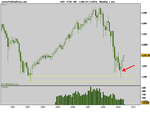barjon
Legendary member
- Messages
- 10,752
- Likes
- 1,863
....and out at the death
Fully fledged trends are easy to spot in hindsight, as are completed ones. In at the birth and out at the death is the ideal, but probably only something Mystic Meg can aspire towards. For most of us the birth requires some confirmation, maybe whilst the little blighter is still in shorts pants at primary school, or in longs at secondary school, or on graduation from college, or when? 'Course if you require so much confirmation that you are only convinced as he draws his pension then the fatal heart attack is not long coming.
So, is anyone up for exploring the anatomy of a trend? Let's start with the birth, or near to, if you are.
good trading
jon
Fully fledged trends are easy to spot in hindsight, as are completed ones. In at the birth and out at the death is the ideal, but probably only something Mystic Meg can aspire towards. For most of us the birth requires some confirmation, maybe whilst the little blighter is still in shorts pants at primary school, or in longs at secondary school, or on graduation from college, or when? 'Course if you require so much confirmation that you are only convinced as he draws his pension then the fatal heart attack is not long coming.
So, is anyone up for exploring the anatomy of a trend? Let's start with the birth, or near to, if you are.
good trading
jon


